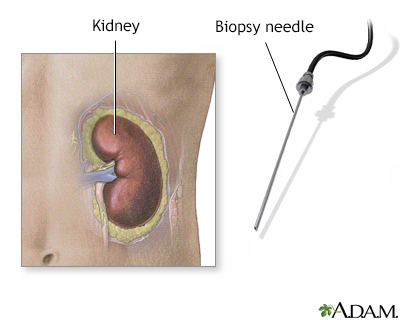Pregnancy SmartSiteTM
Renal biopsy; Biopsy - kidney DefinitionA kidney biopsy is the removal of a small piece of kidney tissue for examination. How the Test is PerformedA kidney biopsy is done in the hospital. The two most common ways to do a kidney biopsy are percutaneous and open. These are described below. Percutaneous biopsy. Percutaneous means through the skin. Most kidney biopsies are done this way. The procedure is usually done in the following way:
Open biopsy. In some cases, your provider may recommend a surgical (open) biopsy. This method is used when a larger piece of tissue is needed or a percutaneous needle biopsy cannot be done safely.
After percutaneous or open biopsy, you will likely stay in the hospital for at least 12 hours. You will receive pain medicines and fluids by mouth or through a vein (IV). Your urine will be checked for heavy bleeding. A small amount of bleeding is normal after a biopsy. Follow instructions about caring for yourself after the biopsy. This may include not lifting anything heavier than 10 pounds (4.5 kilograms) for 2 weeks after the biopsy. How to Prepare for the TestTell your provider:
How the Test will FeelNumbing medicine is used, so the pain during the procedure is often slight. The numbing medicine may burn or sting when first injected. After the procedure, the area may feel tender or sore for a few days. You may see bright, red blood in your urine during the first 24 hours after the test. If the bleeding lasts longer, tell your provider. Why the Test is PerformedYour provider may order a kidney biopsy if you have:
Normal ResultsA normal result is when the kidney tissue shows normal structure. What Abnormal Results MeanAn abnormal result means there are changes in the kidney tissue. This may be due to:
RisksRisks include:
ReferencesSalama AD, Cook HT. The renal biopsy. In: Yu ASL, Chertow GM, Luyckx VA, Marsden PA, Karl S, Philip AM, Taal MW, eds. Brenner and Rector's The Kidney. 11th ed. Philadelphia, PA: Elsevier; 2020:chap 26. Topham PS, MacGinley. Kidney biopsy. In: Johnson RJ, Floege J, Tonelli M, eds. Comprehensive Clinical Nephrology. 7th ed. Philadelphia, PA: Elsevier; 2024:chap 7. | |
| |
Review Date: 8/28/2023 Reviewed By: Walead Latif, MD, Nephrologist and Clinical Associate Professor, Rutgers Medical School, Newark, NJ. Review provided by VeriMed Healthcare Network. Also reviewed by David C. Dugdale, MD, Medical Director, Brenda Conaway, Editorial Director, and the A.D.A.M. Editorial team. The information provided herein should not be used during any medical emergency or for the diagnosis or treatment of any medical condition. A licensed medical professional should be consulted for diagnosis and treatment of any and all medical conditions. Links to other sites are provided for information only -- they do not constitute endorsements of those other sites. No warranty of any kind, either expressed or implied, is made as to the accuracy, reliability, timeliness, or correctness of any translations made by a third-party service of the information provided herein into any other language. © 1997- A.D.A.M., a business unit of Ebix, Inc. Any duplication or distribution of the information contained herein is strictly prohibited. | |

 Kidney anatomy
Kidney anatomy Kidney - blood and...
Kidney - blood and... Renal biopsy
Renal biopsy
